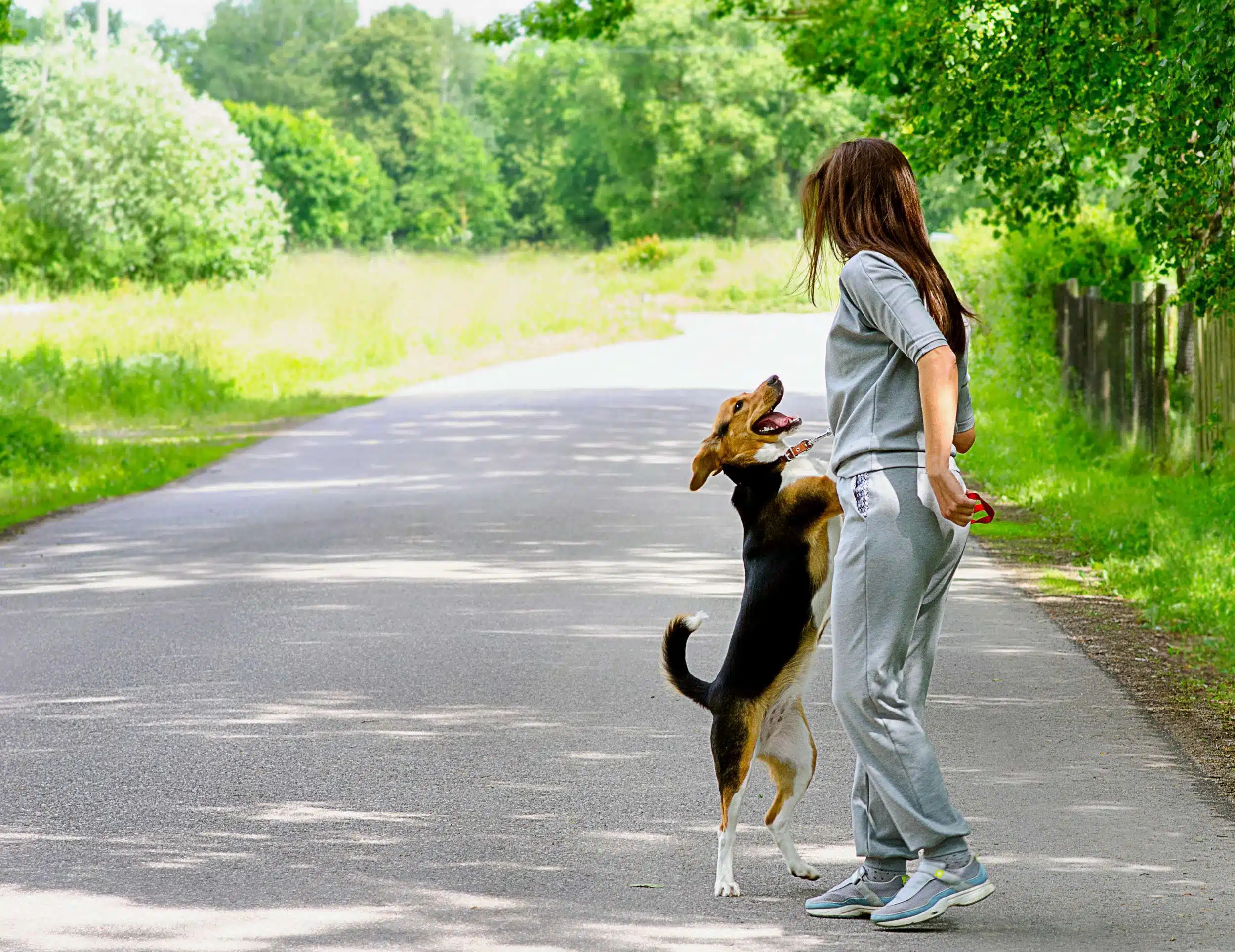As a dog owner, one of your primary responsibilities is to ensure the well-being of your pet, and a big part of that is understanding their emotional state. Stressed dog body language can be subtle or overt, but recognizing these signs is essential for providing the necessary support and care. This blog post delves into the details of stressed dog body language, helping you identify and alleviate your pet’s anxiety.
Stressed Dog Body Language
Causes of Stress in Dogs
Various factors can trigger stress in dogs. Common causes include loud noises, changes in their environment, new or too many people, confined spaces, and changes in routine. Identifying what causes stress in your dog is crucial to managing and reducing their anxiety effectively.
Signs of Stressed Dog Body Language
Recognizing stressed dog body language involves observing changes in normal behavior. Here are specific signs to watch for:
Pacing and Shaking
One of the first signs of stressed dog body language is pacing or shaking. This behavior indicates discomfort and an inability to settle. When a dog paces, it may walk back and forth along the same path repeatedly or wander aimlessly without settling in one spot for long. Shaking or trembling, often mistaken for being cold, can actually be a sign that a dog is stressed or anxious. These behaviors are the body’s physical response to stressors and indicate that the dog is not at ease with the current situation. It’s important for dog owners to recognize these signs early to help calm their pet and address the underlying causes of their discomfort.
Excessive Whining or Barking
Excessive Whining or Barking: Vocalization is a common stress response in dogs. If your dog is whining or barking more than usual, this could be a sign of stress. Dogs often vocalize to express their emotions and needs, and excessive noise can indicate that they are feeling anxious, scared, or overwhelmed. It’s important to listen to these cues and try to understand what might be causing the stress. This could stem from environmental factors, a disruption in routine, or even a health issue. Identifying and addressing the root cause of the excessive whining or barking can help alleviate your dog’s stress and restore their sense of calm.
Yawning, Drooling, and Licking
While these behaviors might seem typical for dogs, exhibiting them in excess is often an indication of stress. Excessive yawning can be more than just a sign of tiredness; it’s a common stress signal in dogs. Similarly, drooling and licking excessively can also point to anxiety or nervousness. Dogs may lick themselves, objects, or people as a self-soothing behavior when they feel stressed or uncomfortable. Observing these behaviors in your dog, especially when they occur more frequently or intensely than usual, should prompt further attention and care to determine what is causing their stress and how it can be alleviated. Recognizing these signs early can help prevent stress from escalating and affecting your dog’s overall health and happiness.
Eyes and Ears
Stressed dog body language can often be observed through changes in their eyes and ears. Dilated pupils or an averted gaze, where a dog consistently looks away, can indicate discomfort or anxiety. Showing the whites of the eyes, often referred to as “whale eye,” is another clear sign that a dog is stressed or feeling threatened. The positioning of the ears is equally telling; ears that are pinned back flat against the head typically suggest fear or anxiety. These visual cues are crucial for understanding how a dog is feeling internally and can help owners and caretakers respond appropriately to reduce the dog’s stress and ensure their well-being. Recognizing these signs promptly can help to address the dog’s discomfort in a timely manner, potentially preventing more severe anxiety responses.
Tail Positioning
Observing a dog’s tail can provide significant insights into its emotional state. A low or tucked tail, unlike the natural, relaxed wagging, is often a strong indicator of stress or anxiety in dogs. This tail positioning reflects a dog’s attempt to make itself appear smaller or less threatening, signaling discomfort or fear. Monitoring this aspect of stressed dog body language is crucial as it can help identify when a dog feels threatened or uneasy in its environment. Addressing these feelings early can help prevent further stress and create a more secure and comfortable setting for the dog.
Body Posture
The body posture of a dog is a vital indicator of its emotional state. A dog showing signs of stress may display a lowered body posture, where they might crouch close to the ground as if they are trying to make themselves small. Alternatively, they may stiffen up, standing rigidly with minimal movement. These postures indicate a response to anxiety, discomfort, or fear. Recognizing these subtle changes in body language is crucial for effectively responding to a dog’s stress. By observing these signs, owners can better understand when their dog feels threatened or uneasy, allowing them to provide appropriate interventions such as a calming environment, reassurance, or removal from stressful situations. This proactive approach can significantly enhance the dog’s sense of security and well-being.
Shedding and Panting
Two signs of stressed dog body language that are often overlooked are increased shedding and panting without exertion. While it’s natural for dogs to shed and pant, an uptick in these behaviors without a clear physical cause can be a signal of stress. Panting can be especially pronounced when a dog is trying to cool down, but when it occurs in a relaxed environment, it indicates anxiety or stress. Similarly, shedding can increase in response to stressful situations as part of the body’s natural reaction to heightened emotion or nervousness. Recognizing these signs as potential indicators of stress can help dog owners take timely steps to address their pet’s anxiety, such as providing a calming environment, ensuring adequate hydration, and consulting with a veterinarian if the behaviors persist.
Hiding or Avoidance
If your dog is hiding under furniture, staying in a separate room from where the family gathers, or avoiding interaction with people and other pets, it’s a significant indicator of stress. This form of stressed dog body language shows a clear need for safety and comfort. Dogs may seek out secluded spaces when they feel overwhelmed or threatened in their environment. It’s important for owners to recognize these behaviors as a plea for help or a sign that the dog needs a safe, quiet place to retreat. Addressing these needs by providing a secure and comforting space can help alleviate stress and make the dog feel more secure in their home environment. Additionally, understanding what triggers these behaviors can aid in modifying the environment or interactions that cause distress, ultimately helping your dog feel more relaxed and engaged.
Bodily Functions
Changes in bodily functions such as diarrhea or increased urination are critical indicators of stressed dog body language. Stress can significantly impact a dog’s physiological processes, leading to digestive upset or a change in urinary habits. These symptoms can arise from anxiety, nervousness, or fear, affecting a dog’s overall health. When a dog experiences stress, its body may release excess cortisol, which can disrupt normal digestive and excretory functions. If you notice these changes in your dog, it’s important to consider the potential stressors in their environment and address them. Moreover, consulting with a veterinarian is advisable to rule out medical causes and to discuss ways to help manage your dog’s stress effectively, ensuring their health and comfort are maintained.
Also Read: What is the Origin of the Word “Dog”?
How to Respond to Stressed Dog Body Language

Stressed Dog Body Language
Understanding stressed dog body language is crucial, but knowing how to effectively respond is equally important. Here are some actionable steps to help your stressed dog:
1. Provide a Safe Space
Create a designated area in your home where your dog can retreat when feeling overwhelmed. This space should be quiet, comfortable, and easily accessible at all times. It can be a cozy corner with their favorite bed and toys, or a special room where they can unwind without disturbances.
2. Maintain a Routine
Dogs are creatures of habit and thrive on consistency. Keeping a regular schedule for feeding, walks, and playtime helps provide a sense of security. Routine reduces uncertainty, which can be a significant source of stress for dogs.
3. Increase Exercise and Play
Regular physical activity is essential for reducing stress in dogs. Exercise helps burn off excess energy that can otherwise fuel anxiety. Ensure that activities are enjoyable and tailored to your dog’s health, age, and preferences. Play sessions, interactive games, and regular walks can all contribute to lowering stress levels.
4. Seek Professional Advice
If your dog’s stress symptoms are severe or persistent, it’s important to consult with professionals. A veterinarian can rule out any underlying health issues that might be contributing to your dog’s stress. Additionally, a professional dog behaviorist can offer insights and specific strategies tailored to your dog’s needs. They can help you understand the root causes of your dog’s stress and develop a comprehensive plan to address it.
5. Use Calming Aids
Consider using tools such as calming treats, anxiety wraps, or pheromone diffusers. These aids can help soothe your dog and reduce stress levels, especially in situations known to cause anxiety, such as thunderstorms or fireworks.
6. Positive Reinforcement
Use positive reinforcement techniques to encourage calm behavior. Reward your dog with treats, praise, or affection when they show signs of relaxation or calmness. This not only reinforces desired behaviors but also helps build their confidence.
7. Environmental Management
Modify your environment to minimize stress triggers. If loud noises stress your dog, using white noise machines can help mask these sounds. If strangers make your dog anxious, managing their exposure to new people can help.
Recognizing Your Stressed Dog Body Language
Recognizing stressed dog body language is crucial for any dog owner. By understanding these signs, you can take proactive steps to mitigate stress and improve your dog’s quality of life. Always be attentive and responsive to changes in your dog’s behavior, and provide the comfort and support they need to feel secure.
Know more About These Dog Breeds














Get involved!
Comments